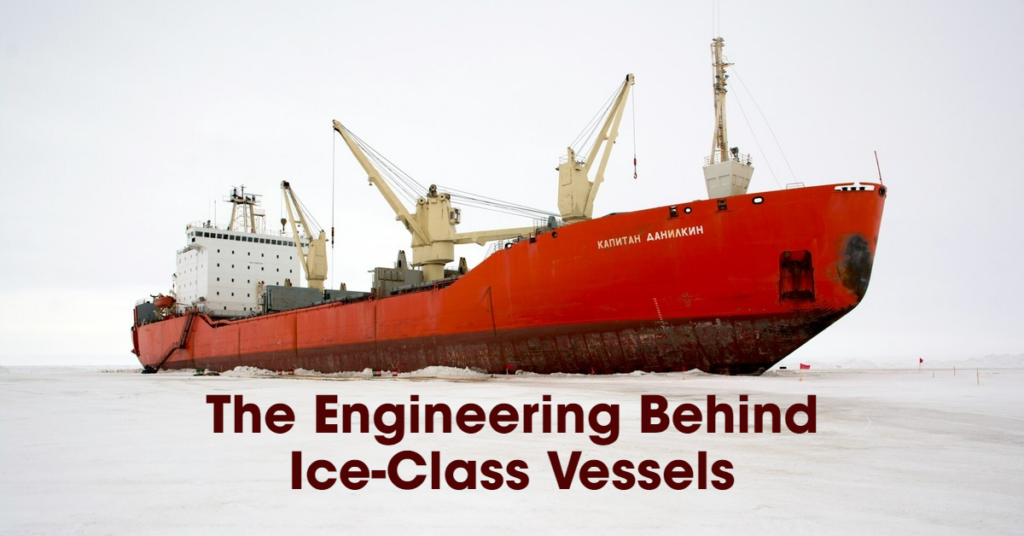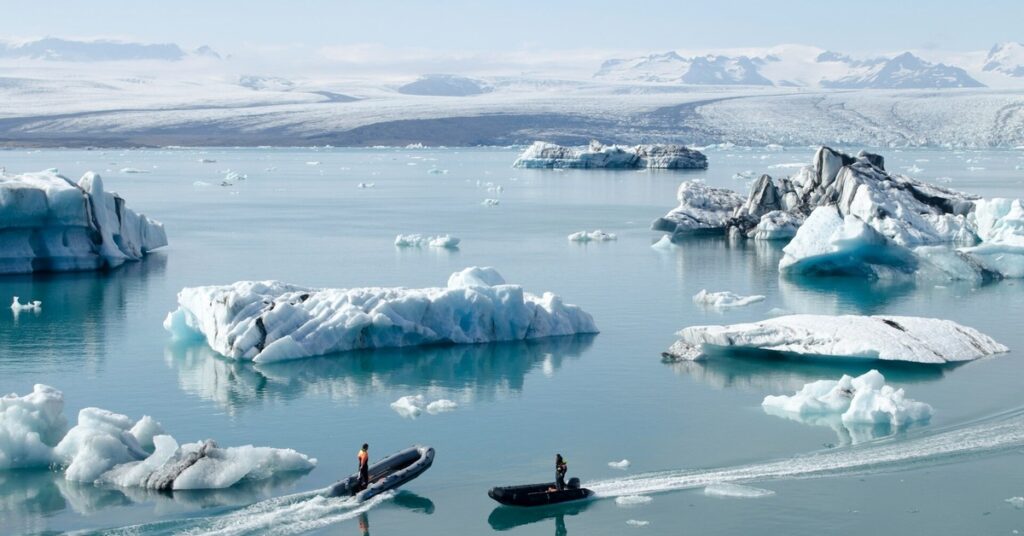Engineering vessels for water travel is complex, and building ice-class ships involves extra challenges. Regions with freezing temperatures, ice sheets and sea smoke are challenging to navigate. Thankfully, technological advancements and modern design have enabled many boaters to brave these inhospitable waters.

What Does Ice-Class Mean?
Ice-class is a classification indicating how a ship is prepared to navigate through sea ice. Compared to regular ships, ice-class ships have permits and arrangements to go through those colder waters. They are also engineered to face and sustain colder waters.
Ice-class ships are generally designed to withstand colder climates, but they can still vary in the extremity they can handle. Not all ships are heading to arctic waters, but they may still face more frigid temperatures.
A study finds that higher ice concentrations increase the probability of besetting in the water, keeping it from maneuvering. Areas with lower clusters can have the baseline configuration to make sure they stay moving in the water.
Meanwhile, ice-class vessels entering areas with accumulated frozen waters need extra durability. One good example is an icebreaker ship, which is meant to break thick ice like those in the polar regions.
Categorization of Ice-Class Ships
Ice-class ships come in all shapes and sizes. The Finnish-Swedish Ice Class is the most recognized standard to dictate the strengthening of these ships, utilized as a guideline by ship engineers. However, there are other international standards, such as the Baltic Ice Classes and the Canadian Arctic shipping regulations. The United States also has its own class notations, presented by the American Bureau of Shipping.
Ice-Class 1A
Ice-class 1A ships face the most challenging conditions, from freezing temperatures to ice caps. Icebreakers usually fall under this category since they are fully strengthened for those scenarios. The ship should be able to handle ice thickness of 1 meter at the very least.
However, specific engineers can enable these vessels to go the distance to handle the coldest waters. The Finnish-Swedish Ice-Class may refer to these vessels as 1A Super.
Ice-Class 1B
Ice-class 1B has moderate ice-strengthening capabilities, reaching a thickness of half a meter. These impressive ships are usually used for cargo vessels traveling far distances and in colder waters. There are models still fashioned with an icebreaker to face more challenging pathways.
Ice-Class 1C
Ships under Ice-Class 1C have light ice-strengthening features. They can handle thin ice at best, and it’s wise to avoid prolonged exposure. There are extra categories like Class 1D and 1E with minimal reinforcement, ideal for only extremely light sailing conditions.
What Are Ice-Class Vessels Made Of?
Ice-class boats can run through all sorts of ice, from larger masses to loose fragments to flat sheets. It’s essential to choose the right materials when making these vessels. Normal-strength and high-strength steels are used for multiple vessel parts.
Low temperatures may make the steel brittle. The material also expands when exposed to low temperatures, creating ruptures. Ice-class cargo ships must also be vigilant, as the extra load and freezing conditions cause damage.
The strength and integrity of fabricated metal can influence operational safety and efficiency in the long run. It’s important to select suitable materials when engineering the vessel. Pay close attention to water-exposed parts of the ship like the hull and propellers, as they have to bear the brunt of the cold water.
The Design of Ice-Class Vessels
Ship design for ice-class vessels varies widely. Project 22220 icebreakers are around 568 feet in length and 33,500 tons in weight. Meanwhile, the ARA Almirante Irízar spans 397 feet and displaces around 14,899 tons. These titans are usually reserved for expeditions into the Antarctic. Other ice-class vessels are smaller.
Strong structural integrity is the primary consideration in engineering. An ice-class vessel’s hull will have to face frozen water and ice, requiring more strengthening than other ships. Shell plating usually ensures the vessel withstands the ice and drifts through. Depending on its configuration, it could even break ice sheets.
Decks and other exposed areas are subject to colder temperatures that cause moisture to develop, so it’s critical to add reinforcements. Rails are important to prevent the crew from slipping off. Interior hubs with heaters are also key to facing long-term travel into these colder regions.

Other Additions to Ice-Class Ships
Multiple systems impact an ice-class ship’s safety when traversing colder waters. It mainly lies on a powerful propulsion system, reliable navigation controls and functional communication devices.
Propulsion System
Propulsion systems are typically submerged in cold water, so they must be powerful enough to propel the vessel forward. Ice-class vessels will typically have multiple mechanisms, either involving electric or mechanical transmission. Either way, these systems need a continuous diesel flow to boost movement.
The propellers and rudder of the propulsion systems should also be well reinforced. Icebreakers will typically have strengthened tips to withstand stronger types of ice. Others may invest in fixed-pitch or controllable-pitch propellers for better maneuverability.
Ice-class vessels break through these formations, but they should not do so haphazardly. If anything, they should go through the pathway with the least amount of ice. It’s key to look for thinner sheets and chunks.
Radar-based systems can detect and track ice. Sonar-based technology can also monitor and profile ice movement. Captains and crew should use this information to navigate through the waters and arrive at their destination safely.
Communication Device
Certain ice-class ships undertake remote operations and expeditions. In emergencies, people onboard should have a communication system and request assistance. Communication devices can be helpful even outside of remote travel.
For example, ships could coordinate and warn one another about the icy conditions and advise them to take alternative pathways instead. Radiotelephone is ideal since these devices still have a signal despite the subzero temperatures.
Handling Ice-Class Ships
Engineering is step one of braving the cold waters. Several ice-class ships are designed to face arctic conditions, yet they only make it through and past those waters when handled correctly. Training and safety is key.
Crew Training
The crew should understand the intricacies behind an ice-class vessel to know how they can service the reinforcements and structure during emergencies. They should also be equipped with personal protective equipment against the cold.
It’s also best to advise them on how to keep warm throughout the travel. If there’s any cargo involved, there should also be procedures for keeping it safe and insulated throughout the ice-class ship’s journey.
Safety Protocols
Ice-class vessels may undergo several emergencies. For instance, captains may underestimate the thickness of a formation and unintentionally beset the ship. In those cases, it’s essential to keep the vessel moving. Some have breaking modes installed for these reasons.
Sea smoke also inhibits visibility. Colder temperatures can even cause fog to freeze the hulls of ships. Reduce ship speeds and reroute to avoid areas with dirty air. Focus on safety and gaining back visibility rather than plowing through and hitting obstacles.
Sustainability Measures
Ships that undergo deeper expeditions should have sustainable measures in place. Ice-class vessels use 13% more main engine power, which affects fuel efficiency. Greywater is also discharged into vulnerable oceans.
It’s ideal to use low-toxic fuel when threading into these regions. Future developments of ice-class vessels must also explore the use of renewable energy. As for the wastewater, it’s best to store and discharge it in permissible areas.
The Art of Ice-Class Vessels
Ice-class ships are in a league of their own, as they can weather colder climates and harsh waters. They have made the journey safer for boaters and opened up new pathways, and it’s all thanks to the mastery of its engineering and design.
Frequently Asked Questions
What Is an Ice-Class Vessel?
An ice-class vessel is a strengthened ship that can navigate through sea ice. Different classifications dictate the ice thickness and extremity that it can withstand.
What Is Ice-Class 1A, 1B and 1C?
Ice-class 1A ships have the strongest ice-strengthening capabilities to handle the most challenging waters. 1B and 1C ships handle moderate and light conditions, respectively.
What Materials Go Into Ice-Class Ships?
Most ice-class ships rely on normal-strength and high-strength steels to withstand colder conditions. It’s important to pick quality materials for optimal safety and efficiency.
How Does an Ice-Class Ship Design Differ From Traditional Ships?
An ice-class ship will have a more robust structural integrity and propulsion system. Hulls are reinforced to break ice formations and create a pathway.
What Are the Main Challenges of Ice-Class Ships?
The main challenges ice-class ships face are the unpredictability of routes and lack of visibility. It’s best to combat these obstacles with high-tech navigation systems and better handling.
- The 15 Most Exciting New Ships of 2025 – January 6, 2025
- How Old Do You Have to Be to Drive a Boat? – November 12, 2024
- The Engineering Behind Ice-Class Vessels – September 20, 2024



